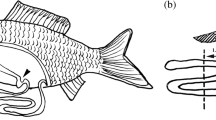Summary
The epithelium of the gills of Mytilus edulis L. is able to absorb particles and proteic molecules by the mechanism of athrocytosis. This absorption appears exclusively in three zones near the marginal furrow. The athrocytosis is discriminating, certain particles (acidic dyes) being refused, others (Indian ink, thorotrast) being accepted, independently of the size of the particle. The absorption zones for proteins (ferritine and peroxidase) are far more extended than those for particles (Indian ink and thorotrast). Experimental and electronmicroscopical analysis allow the conclusion that absorption by amoebocytes is a secundary event and intervenes after (and by) the first absorption by the epithelium. An E.M. study shows that the absorbing areas of the epithelium contain several categories of cells, differing by their cilia or the size of their villosities. In all these cells there is an intense pinocytosis and a great number of lysosomes. Presence of ferritin has been demonstrated in the lysosomes when fragments of gills have been placed 1–2 h in a solution of ferritin. No athrocytosis whatever appeared in young, sexually immature Mytilus; in this case M.E. showed absence of pinocytic vesicles and lysosomes in the epithelium. Two mechanisms of mucus formation have been described electronmicroscopically.
Résumé
L'épithélium branchial de Mytilus edulis L. est susceptible d'athrocyter des particules et des molécules protéïques. Cette absorption se manifeste uniquement dans trois zones voisines du sillon marginal. L'athrocytose est discriminante, certaines particules, comme les colorants acides, étant refusées, tandis que l'encre de Chine et le thorotrast sont acceptés, ce choix étant indépendant de la taille de la particule. Les zones d'absorption des molécules protéïques (ferritine et peroxidase) sont plus étendues que celles qui absorbent des particules. L'expérimentation ainsi que l'étude cytologique permettent d'affirmer que le rôle des amibocytes est secondaire et que la pénétration primaire se fait dans l'épithélium. Une étude au microscope électronique démontre que les territoires s'étendent sur plusieurs catégories cellulaires, différant par la ciliation et la nature des villosités. Dans toutes ces cellules, se manifestent une intense pinocytose ainsi que de nombreux lysosomes issus d'amas golgiens. La présence de ferritine a pu être démontrée dans les lysosomes. Dans les moules jeunes, non encore arrivées à maturité sexuelle, aucune possibilité d'athrocytose n'a pu être décelée; corrélativement, les filaments branchiaux ne montrent au M.E. pas de vésicules de pinocytose et pas de lysosomes. La M.E. nous a permis de décrire les deux mécanismes de formation du mucus.
Similar content being viewed by others
Bibliographie
Anderson, E.: Oocyte differentiation and vitellogenesis in the roach Periplaneta americana. J. Cell Biol. 20, 131–155 (1964).
Atkins, D.: On the ciliary mechanisms and interrelationships of Lamellibranchs, I–IV. Quart. J. Micr. Sci. 79, 181–308 (1936); 79, 339–445 (1937); 80, 321–346 (1938); 84, 187–256 (1943).
Bevelander, G., and H. Nakahara: Correlation of lysosomal activity and ingestion by mantle epithelium. Biol. Bull. 131, 76–82 (1966).
Cordier, R.: Etudes histophysiologiques sur la néphridie du Lombric. Arch. Biol. (Liège) 45, 431–471 (1934).
—: Les phénomènes d'athrocytose et de phagocytose dans la nephridie et dans le néphron. Essai d'histophysiologie comparée. Ann. Soc. roy. Zool. Belg. 44, 115–132 (1934).
—: Sur le pouvoir athrocytaire et phagocytaire des plexus choroîdes chez le Crapaud. C. R. Soc. Biol. (Paris) 126, 1276–1278 (1937).
Ferguson, J. C.: Utilization of dissolved exogenous nutrients by the starfishes, Asterias forbesi and Henricia sanguinolata. Bull. Biol. 132, 161–173 (1967).
Fretter, V.: Experiments with radioactive strontium (90 Sr) on certain molluscs and polychaetes. J. Mar. Biol. Ass. U.K. 32, 367–384 (1953).
Gerard, P., et R. Cordier: Esquisse d'une histophysiologie comparée du rein des Vertébrés. Biol. Rev. 9, 110–131 (1934).
— —: Recherches d'histophysiologie comparée sur le Proet le Mésonephros larvaires des Anoures. Z. Zellforsch. 21, 1–23 (1934).
Hatt, P.: L'absorption d'encre de Chine par les branchies de Mollusques. Arch. Zool. exp. gén. 65, 89–95 (1926).
Nakahara, H., and G. Revelander: Ingestion by the mantle epithelium in Molluscs. J. Morph. 122, 139–142 (1967).
Pasteels, J. J.: Absorption et athrocytose par l'épithelium branchial de Mytilus edulis. C. R. Acad. Sci. (Paris) 264, 2505–2507 (1967).
Pequignat, E.: “Skin digestion” and epidermal absorption in irregular and regular urchins and their probable relation to the outflow of spheruloecoelomocytes (Echinocardium cordatum, Psammechinus miliaris, Asterias rubens, Ophiotrix fragilis). Nature (Lond.) 210, 397–399 (1966).
Pomeroy, L. R., and H. H. Haskins: The uptake and utilization of phosphate ions from sea water by the american oyster Crassostea virginica (Gmel). Biol. Bull. 107, 123–129 (1954).
Pütter, A.: Die Ernährung des Wassertiere durch gelöste organische Verbindungen. Pflügers Arch. ges. Physiol. 137, 595–621 (1911).
Ranson, G.: L'absorption des matières organiques dissoutes par la surface extérieure du corps chez les animaux aquatiques. Ann. Inst. Océan. 4, 50–174 (1927).
Ronkin, R. R.: The uptake of radioactive phosphate by the excised gill of the mussel, Mytilus edulis. J. cell. comp. Physiol. 35, 241–250 (1950).
Roth, J. F., and K. R. Porter: Yolk protein uptake in the oocyte of the mosquito Aedes aegypti L. J. Cell Biol. 20, 313–332 (1964).
Straus, W.: Rapid cytochemical identification of phagosomes in various tissues of the rat and their differentiation from mitochondria by the peroxydase method. J. biophys. biochem. Cytol. 5, 193–204 (1959).
Takatsuki, S.: On the nature and functions of the amoebocytes of Ostrea edulis. Quart. J. micr. Sci. 76, 379–431 (1934).
Yonge, C. M.: Evolution and adaptation in the digestive system of the Metazoa. Biol. Rev. 12, 87–115 (1937).
Author information
Authors and Affiliations
Rights and permissions
About this article
Cite this article
Pasteels, J.J. Pinocytose et athrocytose par l'épithélium branchial de Mytilus edulis L.. Z.Zellforsch 92, 339–359 (1968). https://doi.org/10.1007/BF00455591
Received:
Issue Date:
DOI: https://doi.org/10.1007/BF00455591



